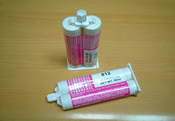 |
|

|
 |
|
CYBERCRYL™ 812 结构组装用胶 Clear High Strength Structural Adhesive |
|
透明
低黏度 高强度 |
 |
|
Cybercryl 812 is a methacrylate-based structural adhesive designed to provide clear bond lines. Cybercryl 812 forms tough, durable bonds to many diverse substrates including engineered plastics, composites, metals, glass and ceramic. It is best used to bond polycarbonate, acrylics, PVC to each other or to other substrates. In most cases surface preparation is not necessary. |
| 适合材质 : Suitable Substrates to bond | |
| 铝, 铝合金, 铁, 不锈钢, 铜, PMMA, ABS, ABS+PC, ABS+Glass fiber, PVC,FRP,陶瓷...等 | |
| Aluminum, Aluminum alloy, steel, Stainless steel, ABS, PMMA, Nylon, ABS+PC, FRP, Ceramic, Wood... |
| FEATURE - Cybercryl 812 特色 : | 相关资料 Reference Data: | ||
| 抗冲击特性. |
产品技术数据 Data Sheet | ||
| 物质安全数据表 MSDS | |||
| 型录下载 Catalogue Download | |||
| 使用说明 Useful Hit | |||
| Dual Cartridge operation | |||
| 技术咨询 Technical Inquire | |||
混合管规格 Mixer Specifications |
|||
| TS 16949 品质认证 | |||
Dispense design |
|||
| 何处购买 Where to buy | |||
| 包装 Package | |||
50ml dual cartridge |
|||
 |
| 产品线设计 Producing Line Design: | |
|
| 使用方式 : Instructions For Use | |
| Dual
Cartridge Application: 若使用专用Dual-cartridge胶枪(50ml 包装), 接着剂挤出时会经过前端之静态混合管(static mixer)依比例混合, 混合后之接着剂直接施胶于欲组装之其中之一工件上, 再可工作时间(working time)内将两工件组合, 较小之工件可使接着剂溢胶以增加接着面积获得更高之接着强度, 间系较大之工件有时需两面上接着剂, 并轻压使接着剂分散以确保接着剂与两材质接触到. Typical Process Methods Apply mixed adhesive directly to one surface in even or beaded manner. Assemble the parts within the recommended working time. Obtain firm contact between the parts to minimize any gap and ensure good contact. A small fillet of adhesive should flow out of the edges to show adequate gap-filling. For large gaps, apply enough adhesive to both surfaces and spread to cover the entire area, or make a bead pattern on both sides which will allow flow throughout the bond line. |
|
Copyright 2006 上海捷德化工有限公司 版权所有 中华人民共和国信息产业部 ICP备案号/许可证:沪ICP备06030505号
TEL:+86-21-6427-1448 FAX:+86-6486-3684 Email: sales@jedo.cn
